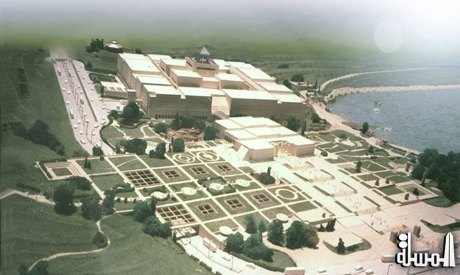
The cultural section of the National Museum of Egyptian Civilization is to open end of November
The cultural section will include a theatre, state-of-the-art lecture halls and high-tech laboratories among others
Following a three-year hiatus, the cultural section of the National Museum of Egyptian Civilization (NMEC), located at the Al-Fustat area overlooking Ain Al-Sira Lake, is to open at the end of November, announced antiquities minister Mamdouh Eldamaty on Monday. The minister made his announcement during his tour around the museum’s different sections to inspect the work being achieved to complete the long-awaited NMEC.

Khaled El-Enany director general of the NMEC told Ahram Online that the cultural section includes a two-story theatre and lecture and conference halls well equipped with state-of-the-art projectors, media, sound and lighting systems. A collection of 42 shops, cafeterias and restaurants with a serving capacity of 500 people will also be part of the section.
El-Enany explains that this section is to be open not only to announce to the world that the NMEC is on its way to see the light of day but also to create a source of fundraising in an attempt to spruce up the required work needed to complete the third and final phase of the project.
He went on to say that the shops, cafeterias and restaurants would sell souvenirs, handicrafts, and books on topics such as history, arts, and archaeology. A parking lot with a capacity of 450 cars and 55 buses will also be built.
The NMEC’s high-tech laboratories and storehouse are to be also inaugurated. The storehouse, El-Enany said, is the first to be built in Egypt and is similar to the ones at the Louvre in Paris and the British Museum in London. The labs will be dedicated to the examination and restoration of human remains and organic materials.
The three-phase construction of the 33 feddans at NMEC started in 2002 by laying down its pyramid-shaped foundation stone. The first phase, which was completed in 2004, included the construction of the laboratories and storehouse. The second phase started immediately afterward and constructed the building itself as well as the cultural centre.
According to the museum’s timeline schedule the NMEC was meant to open in 2011 but was postponed as a result of the January revolution as tourism declined.
In 2012 work resumed at the NMEC but at a slower pace, succeeding in completing the cultural section which is to be inaugurated to public in November.
The NMEC is to put a collection of 150,000 artefacts relating to Egypt’s civilisations along the span of history on display. These artefacts were carefully selected from museums and archaeological sites in Egypt. It will also house a set of monuments, among them are the Seboua Temple of Ramses II – now on Lake Nasser; a complete façade of a Fatimid sabil, two columns from King Djoser’s temple at Saqqara, the collection of royal mummies, and the mummy of the ancient Egyptian artist Sanejem which is now on display at the Egyptian Museum in Tahrir Square. The River Nile, handwriting, handicrafts, society and faith are the five main outdoor component themes of the new museum.
Sourse : english.ahram









